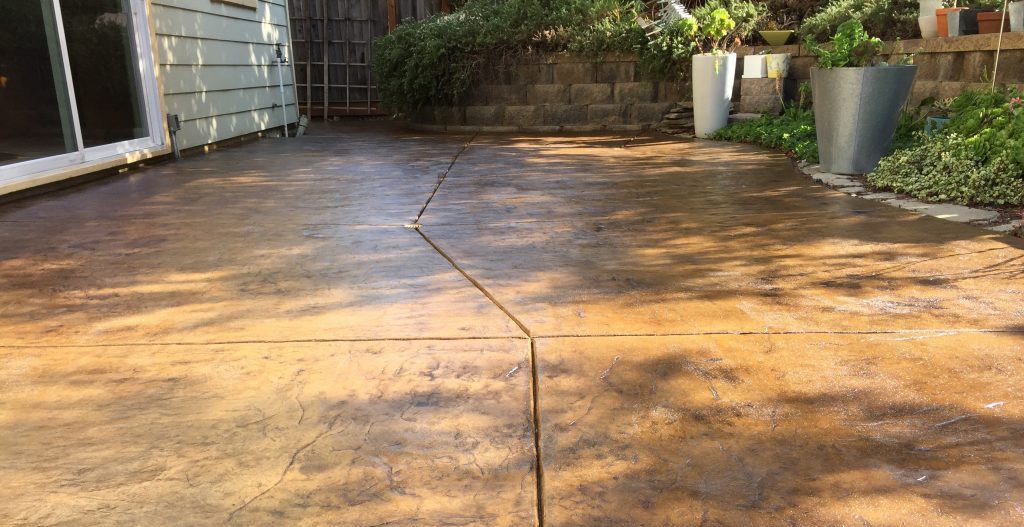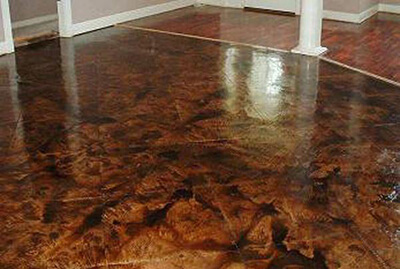What makes local stained concrete an eco-friendly option for designers
Wiki Article
Everything About Stained Concrete: A Comprehensive Guide to Its Advantages and Applications
Stained concrete has actually become a popular option for both household and commercial spaces. Its ability to integrate aesthetic charm with functionality makes it an intriguing option. Various staining techniques offer a series of colors and surfaces, permitting modification. The benefits extend beyond look. Recognizing its applications and upkeep demands is necessary for any person considering this functional material. The subtleties of stained concrete welcome better expedition.What Is Stained Concrete?

Discoloration can be related to numerous surfaces, including floors, driveways, and outdoor patios, making it a functional option for both indoor and outdoor spaces. The treatment can accomplish an array of appearances, from natural tones to vibrant, modern-day layouts. Unlike paint, stained concrete maintains its look in time, as it comes to be an indispensable component of the concrete itself. In general, stained concrete functions as an effective technique for transforming common concrete into visually striking surface areas.
Advantages of Stained Concrete
Stained concrete offers significant benefits, specifically in aesthetic appeal and resilience - local stained concrete. Its vibrant shades and special patterns improve the visual beauty of any type of space, making it a popular selection for both property and commercial applications. Additionally, the durability of stained concrete guarantees that it continues to be a sensible investment over time, standing up to deteriorationVisual Allure
One of one of the most compelling benefits of utilizing stained concrete is its remarkable visual appeal. Stained concrete deals a distinct and functional look that can enhance different design styles, from contemporary to rustic. The infusion of lively colors and complex patterns allows home owners and developers to create personalized surfaces that can boost the general ambiance of a space. Unlike standard flooring choices, stained concrete can mimic the look of natural stone or polished marble, giving a high end appearance without the linked costs. Furthermore, the glossy finish choices can mirror light, further lightening up insides. This adaptability makes stained concrete a popular choice for both property and business applications, where visual impact is extremely important.Durability and Longevity
The remarkable visual qualities of stained concrete are matched by its exceptional toughness and longevity - stained concrete company. Stained concrete surfaces are resistant to damage, making them appropriate for high-traffic locations both inside and outdoors. Their robust nature means they can endure extreme climate problems, consisting of severe temperature levels, rainfall, and UV direct exposure, without significant degradation. Furthermore, stained concrete needs very little upkeep contrasted to various other floor covering alternatives, as it does not require constant sealing or refinishing. This durability not just lowers replacement costs yet also adds to a lasting structure strategy. Overall, stained concrete provides a long-lasting remedy that incorporates aesthetic allure with functional advantages, guaranteeing its worth graduallyDifferent Types of Staining Techniques
Different discoloration strategies can significantly affect the aesthetic qualities of concrete surfaces. The 3 main techniques include acid discoloration, which responds chemically with the concrete, water-based discoloration, which provides a broader range of colors, and overlay discoloration alternatives that give a fresh surface area. Each strategy has special features and applications that satisfy numerous design choices and task requirements.
Acid Staining Method
Exactly how can property owners transform simple concrete surfaces right into visually striking attributes? One efficient approach is acid staining, a preferred method that enhances the natural beauty of concrete. This procedure involves using a service of water, hydrochloric acid, and metallic salts to the concrete surface area. As the acid reacts with the lime existing in the concrete, it develops abundant, variegated shades that appear like marble or rock. Acid discoloration is known for its resilience and resistance to fading, making it a lasting choice for both interior and exterior applications. It is essential to keep in mind that the results can vary based on the initial concrete color and structure. Correct application and sealing are important for attaining the desired aesthetic and durabilityWater-Based Discoloration Technique
A popular option to acid discoloration, the water-based discoloration strategy provides house owners a versatile method to improve concrete surface areas. This method uses water-soluble dyes and pigments, allowing for a large range of colors and surfaces. Unlike acid discolorations, water-based stains can be put on unsealed concrete and provide an easier cleaning process. The review outcomes can attain a more uniform appearance and can be layered to create distinct impacts. Furthermore, water-based spots are normally much less hazardous and emit fewer volatile organic substances (VOCs), making them extra environmentally friendly. Property owners might value the ability to tailor their concrete surface areas with various shades, enabling creative expression while keeping durability and longevity in their flooring choices.Overlay Staining Options
Various overlay staining alternatives exist for home owners aiming to invigorate their concrete surfaces. One preferred choice is acid discoloration, which reacts chemically with the concrete to generate rich, variegated shades. Another alternative is water-based staining, using a broader shade scheme and simpler application. In addition, concrete overlays can be integrated with patterns for intricate styles, enhancing appearances. For a much more distinctive finish, property owners might consider utilizing stamped overlays that resemble natural products like rock or ceramic tile. Each strategy offers one-of-a-kind benefits, from longevity to customization, permitting a customized touch. Eventually, the selection of overlay discoloration depends on the preferred appearance and the problem of the existing concrete, ensuring a refreshed and appealing surface.Applications of Stained Concrete
Stained concrete deals a versatile option for numerous applications, enhancing both aesthetic appeal and performance. This material is generally made use of in residential, commercial, and industrial settings, making it a prominent option amongst engineers and developers. In homes, stained concrete can act as fashionable flooring or outdoor patio areas, providing an advanced appearance while continuing to be long lasting.In industrial rooms, such as stores and restaurants, stained concrete adds to a contemporary atmosphere and can hold up against heavy foot website traffic. In addition, stained concrete is progressively used in public areas like parks and pathways, where its ability to imitate natural stone or various other products includes visual rate of interest.
Stained concrete is excellent for swimming pool decks and driveways, using a slip-resistant surface that is easy to keep. On the whole, the versatility of stained concrete makes it appropriate for various environments, catering to varied preferences and demands.
Maintenance and Treatment for Stained Concrete
Proper upkeep assures the long life and elegance of stained concrete surface areas. Routine cleaning is essential; making use of a light detergent and water with a soft-bristle brush aids eliminate dirt and gunk without damaging the surface. It is recommended to avoid extreme chemicals that can remove the tarnish or sealant.
Securing stained concrete is important for defense versus dampness, discolorations, and wear. A high-quality sealer should be reapplied every one to 3 years, depending on the web traffic and direct exposure the surface sustains. Additionally, attending to spills promptly will stop discoloration and discoloration.

Cost Factors To Consider for Stained Concrete Projects
When planning a tarnished concrete job, spending plan factors to consider play an important duty in figuring out the overall expense. The expenses connected with stained concrete can vary substantially based on numerous elements. The dimension of the area to be stained straight affects product and labor expenses. Larger rooms will normally need even more sources. Second, the kind of discolor selected-- acid-based or water-based-- can impact rates, with acid spots frequently being extra expensive. Furthermore, the intricacy of the style, consisting of patterns or multiple colors, can boost labor prices. Preparation work, such as cleansing and grinding the concrete surface area, contributes to the initial costs as well. Ultimately, the choice in between do it yourself setup and working with a professional specialist will even more affect the spending plan. Recognizing these aspects makes it possible for homeowners to make enlightened economic choices concerning their stained concrete tasks, ensuring they accomplish the desired aesthetic within their monetary methods.Tips for Choosing the Right Stained Concrete for Your Room
Choosing the right stained concrete for a certain area involves mindful reflection of different elements beyond simply budget plan. First, one should review the designated use the location. High-traffic areas may need even more long lasting surfaces, while ornamental applications can prioritize aesthetic appeals.The shade scheme is another vital element; the selected colors ought to integrate with existing style and lighting. It's additionally essential to consider the surface area appearance, as smooth coatings can improve elegance, while distinctive choices may go to my blog ensure safety and security in wet locations.
Neighborhood climate and ecological problems play a significant duty in the longevity and maintenance of stained concrete, influencing the selection of sealants and surfaces.
Consulting with experts can give beneficial understandings tailored to certain demands, assuring the choice of the ideal stained concrete that straightens with both capability and style.
Often Asked Concerns
Can Stained Concrete Be Applied Over Existing Flooring?
Stained concrete can certainly be applied over existing flooring, supplied the surface area is stable and adequately prepared. This technique enables for a visual upgrade without the requirement for complete removal of the initial floor covering products.How Much Time Does Stained Concrete Last?
Stained concrete can last for decades when appropriately preserved. Elements such as website traffic, ecological problems, and application methods greatly influence its longevity, with numerous installations staying lively and intact for 10 to thirty years.Is Stained Concrete Slippery When Wet?
Stained concrete can be slippery when damp, as the finish might produce a smooth surface area. Nevertheless, making use of non-slip additives or distinctive coatings can reduce this problem, improving safety and security without compromising the aesthetic appeal of the concrete.Can I Tarnish Concrete Myself, or Should I Hire an Expert?
The choice to stain concrete personally or work with a professional joints on skill degree and task complexity. While DIY discoloration can save cash, specialists guarantee perfect results, especially for detailed styles or huge surface areas.What Color styles Are Offered for Stained Concrete?
The range of shades available for stained concrete includes natural tones like browns and tans, lively tones such as reds and blues, and softer hues like pastels. This combination permits imaginative, tailored layout choices.Report this wiki page